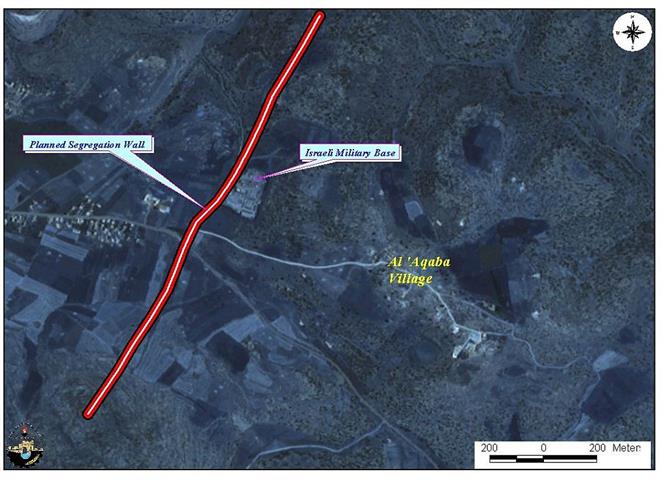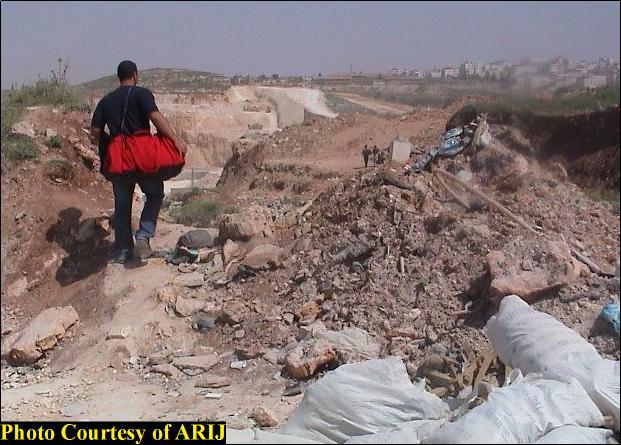The Israeli authorities have mounted an intense campaign of house demolitions in the Palestinian territories to construct the Segregation Wall. It became clear that the campaign objective is not security as the Israeli media and government claim; if so, then the Israeli government would have planned to erect the Segregation Wall at the 1948 Armistice Line (according to UN resolutions which recognize the West Bank and the Gaza Strip as occupied territories).
Things do not stop at that limit, but such Israeli activities are causing indirect Palestinian transfer from the villages located near the Wall. This Israeli plan represented in the Segregation Wall besides the checkpoints, roadblocks and other physical barriers found in the West Bank, segregate Palestinian localities from each other and result in depriving the Palestinians their right to economic, educational, medical, and social service activities necessary for a healthy society.
On the 22nd of October 2003, The Israeli forces handed the residents of Al 'Aqba village 13 house demolishing orders. These orders came as the Israelis planning to commence the construction of another part of the Segregation Wall at the Village entrance. The Israeli authorities claim that these orders had nothing to do with the Segregation wall, but the houses didn't have proper licenses and villagers were given three days to appeal the orders in Beit El headquarters. The Wall, if implemented, would cut off the village from the nearby villages such as Tayasir and the rest of Tubas district and will deprive the residents from all the necessary services. See Satellite image
Among the villagers who were handed demolition orders: Saleh Mohammed Saleh Taleb, Nayef Abdel-Kareem Saleh Taleb, and Mohammed Saleh Abdel Kareem Taleb were known. See copy of military warnings 1, 2 and and 3
The village of Al-Aqaba, northeast Tubas district, is in 'Area C' and has no 'boundary plan '. As dozens of other small villages in remote locations, it is considered an 'unrecognized village' which explains the behavior of the IOF in it.
The 200 people main activity is cultivation and sheep rearing. Vast areas of their agricultural lands were confiscated for military and political purposes. Villagers of Al Aqaba were denied from all the essential services through the Israeli pressure frocing them to leave their houses;
The Israeli army imposed several measures on the village since the start of the occupation:
1. After the 1967 war, the Israeli army announced the village of Al Aqaba and the surrounding agricultural lands as closed military areas. The village was severely affected in 1983 as the establishment of Tsefeh military camp started and the daily military maneuvers in the village.
2. Many have left in the recent years; specifically, since the beginning of the second Intifada because of inexorable prohibition of new structures, and IOF brutality. Its land has been confiscated in the past and is in the process of another confiscation. No building permits are given; and recent requests to build a school for children and kindergarten were turned down under various pretexts ;mainly, the village's location in a military area. The 64 students still use public houses offered by residents of the village to practice their right of proper education.
3. The IOF also turned down another recent application to build a kindergarten, as the only one in the village has an asbestos-roof, which represents a threat on the children. The kindergarten has 60 children and is sponsored by the Rural Woman society which was established few years ago with the help of the British Council.
Villagers of Al Aqaba were also prevented from building a medical clinic, a Mosque, and paving of the village roads. See military warnings 4 & 5
4. Electricity and telephone connections to the nearby towns were destroyed by the IO bulldozers in addition to a number of houses and asbestos-roofs of which the house of Saleh Muhammad Saleh and Muhammad Husien Jaber were known.
5. In October 1998, an underground water cistern for crop irrigation costing 100,000 shekels ($23,600) was bulldozed by the Israelis.
6. Since the beginning of the Intifada, eight deaths and dozens of severe injuries including the partial paralysis of the village council leadercaused by the daily military maneuvers in the village.
The village of Al Aqaba is a small minority comparing to other Palestinian communities which are going to be set outside the Wall . See Map of the Segregation Wall
Israel carries out its goal by implementing a number of discriminatory laws and policies. These policies are complimented by the practice of rarely giving Palestinians the housing permits that are needed for legal construction. However, in the face of crowded living conditions, caused in part by the discriminatory policies, many Palestinians decide to provide for the growth of their families by building without the permits. Unfortunately, for the crime of disobeying unjust laws in order to escape unbearable conditions and provide the simple right and necessity of proper housing for their families, these people join the ever-growing list of Palestinians to suffer the loss of their home to Israeli bulldozers.
Prepared by:
The Applied Research Institute – Jerusalem





















